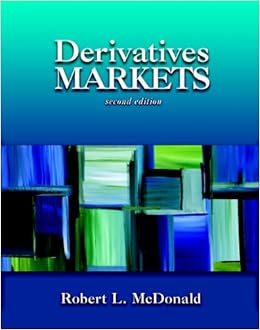
Derivatives Markets (2nd Edition) Download Free (EPUB, PDF)

To be financially literate in today's market, business students must have a solid understanding of derivatives concepts and instruments and the uses of those instruments in corporations. The Second Edition has an accessible mathematical presentation, and more importantly, helps students gain intuition by linking theories and concepts together with an engaging narrative that emphasizes the core economic principles underlying the pricing and uses of derivatives.

Hardcover: 912 pages
Publisher: Pearson; 2 edition (December 25, 2005)
Language: English
ISBN-10: 032128030X
ISBN-13: 978-0321280305
Product Dimensions: 7.6 x 1.6 x 9 inches
Shipping Weight: 3.6 pounds
Average Customer Review: 3.8 out of 5 stars See all reviews (45 customer reviews)
Best Sellers Rank: #488,560 in Books (See Top 100 in Books) #119 in Books > Business & Money > Investing > Futures #400 in Books > Textbooks > Business & Finance > Investments & Securities #700 in Books > Textbooks > Business & Finance > Finance

Far too many books on derivatives are written by academics who claim to be writing for intelligent professionals but are in fact really trying to impress their colleagues. This book is a wonderful exception to that general rule. It is written by a master teacher who understands the importance of knowing several different ways to solve problems, and who provides numerous examples so that the reader can check his/her own answer. The book also provides software in VBA (Visual Basic for Applications) so that the reader can experiment with the results explained in the text and apply them to his/her own problems.McDonald is very concerned to explain the intuition behind the numerous formulas presented in the text, and presents the various chapters in an expertly-designed sequence so that new results nearly always become understandable as more general ways of seeing results presented in earlier chapters. The material progresses gradually from basic to complex, so that the dedicated reader becomes thoroughly acquainted with results that have only recently been discovered. As a consequence, this textbook becomes a handy reference work to be kept at one's desk for daily use.I came across this book more or less by accident, and as I was browsing through it I noted with particular interest several substantial discussions of how derivative pricing can be done with real probabilities so as to arrive at the same results as pricing done with the pseudo-probabilities (or risk-neutral probabilities) discussed in most texts. These sections provided an extremely important clarification of an issue that undoubtedly occurs to nearly all students of derivative pricing but is nonetheless ignored in nearly all of the relevant textbooks and literature.
I had the privilege of using the manuscript of this book for two advanced finance courses I did at Kellogg School of Management (Northwestern University---the Author's home) and just got a chance to read the final published book. This is an excellent book on derivatives markets which should appeal to three types of readers: 1) MBA students doing their first finance course on derivatives; 2) Non-finance professionals who can easily grasp quantitative aspects of derivatives pricing schemes but lack an an intuitive understanding of why, where and how derivatives are used (I was in this category until I attended Kellogg); and, 3) Corporate finance professionals trying to understand different risk management tools. Bob McDonald did a great job in maintaining a good balance between mathematics of derivatives pricing schemes and logical explanations of several economic concepts one would encounter in derivatives. This book is going to be a popular MBA text book very soon.In the first four chapters of the book, the author assumes that the prices of different derivative securities are known and discusses how these securities can be used for insurance and speculation (Chapter 4 has a nice introduction to risk management). Chapters 5-8 explain pricing methods for futures, forwards and swaps using simple discounting models. Chapter 6 has a lucid discussion on how would "futures contract price vs. time" curves for different commodities differ based on the seasonality, transportation costs and storability aspects specific to each commodity.Starting in Chapter 9, the author discusses different option pricing models. The material presented in Chapters 10-13, where in the author discusses binomial option pricing models, Black-Scholes formula and delta hedging, is clearly the highlight of this book.
Derivatives Markets (2nd Edition) Derivatives Markets (3rd Edition) (Pearson Series in Finance) Derivatives Markets (Pearson Series in Finance) Student Solutions Manual for Derivatives Markets Risk Takers: Uses and Abuses of Financial Derivatives (2nd Edition) The Economist Guide to Emerging Markets: Lessons for Business Success and the Outlook for Different Markets (Economist Books) Private Equity Investing in Emerging Markets: Opportunities for Value Creation (Global Financial Markets) Step by Step Emerging Markets Investing: A Beginner's Guide to the Best Investments in Emerging Markets Step by Step Emerging Markets Investing: A Beginner's Guide to the Best Investments in Emerging Markets Stocks (Step by Step Investing Book 4) An Introduction to the Mathematics of Financial Derivatives, Third Edition Options, Futures and Other Derivatives (6th Edition) Options, Futures, and Other Derivatives and DerivaGem CD Package (8th Edition) Options, Futures, and Other Derivatives (4th Edition) Solution Manual for An Introduction to the Mathematics of Financial Derivatives, Second Edition Traders, Guns and Money: Knowns and unknowns in the dazzling world of derivatives Revised edition (Financial Times (Prentice Hall)) Options, Futures, and Other Derivatives (9th Edition) Markets of Paris, 2nd Edition: Food, Antiques, Crafts, Books, and More The Travels of a T-Shirt in the Global Economy: An Economist Examines the Markets, Power and Politics of the World Trade, 2nd Edition Wehrmacht Camouflage Uniforms: And Post-War Derivatives (Europa Militaria) Insurance: From Underwriting to Derivatives: Asset Liability Management in Insurance Companies



